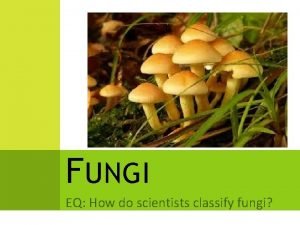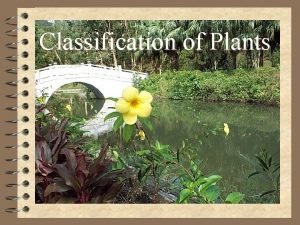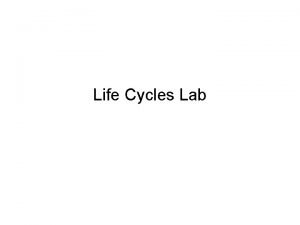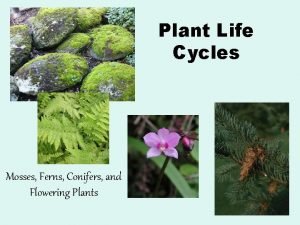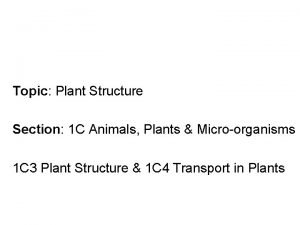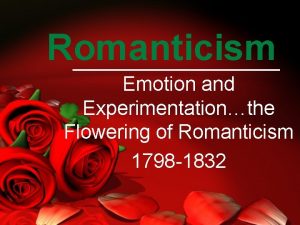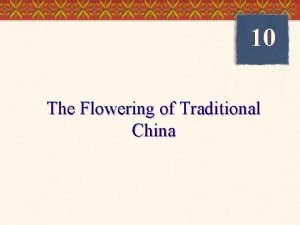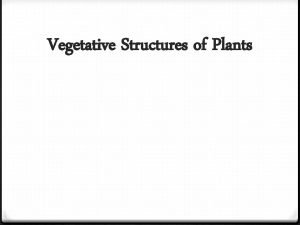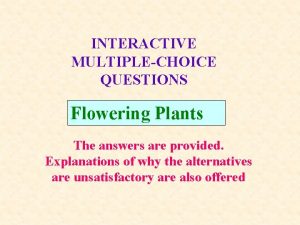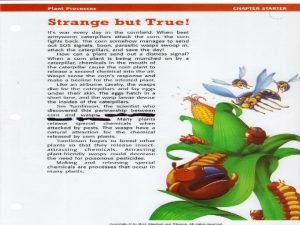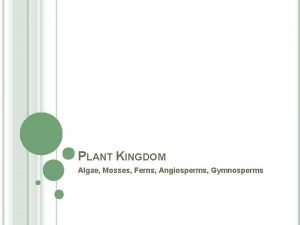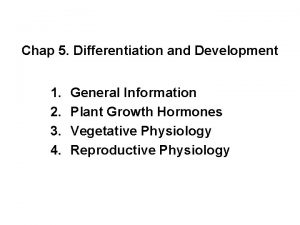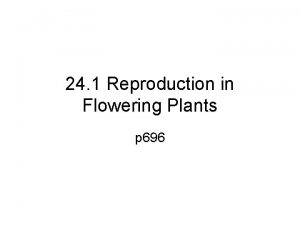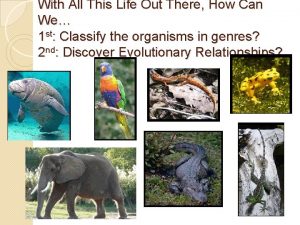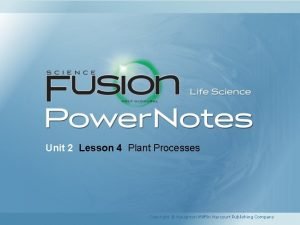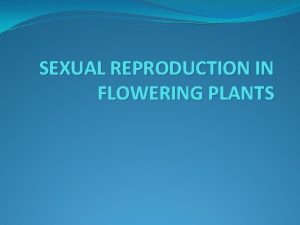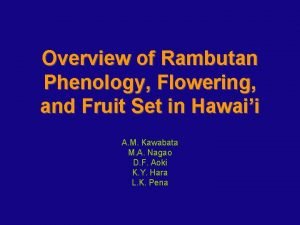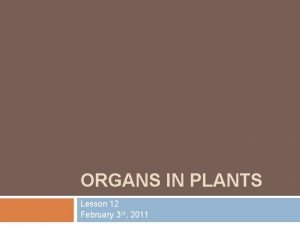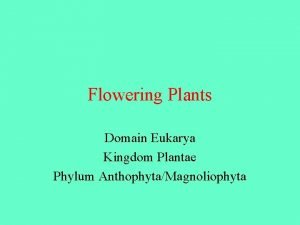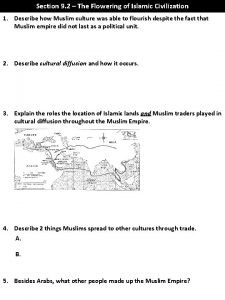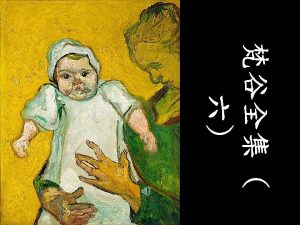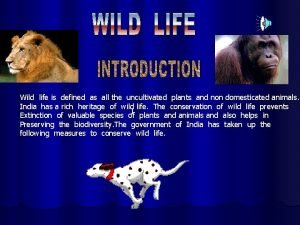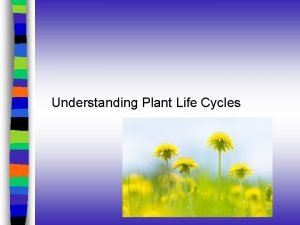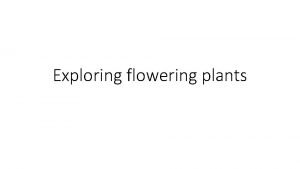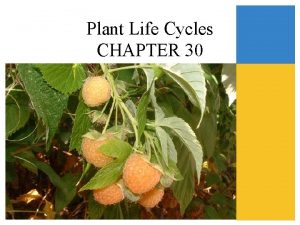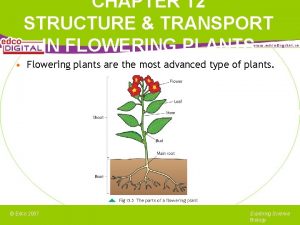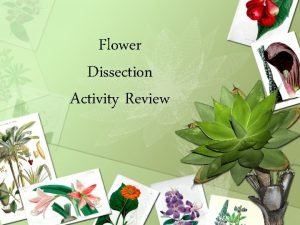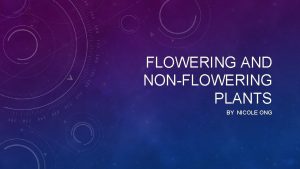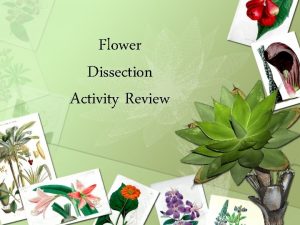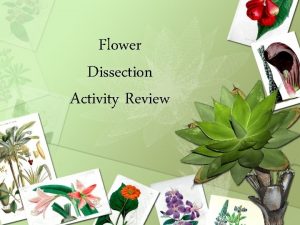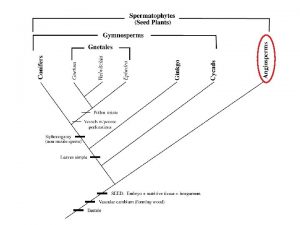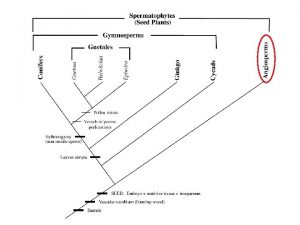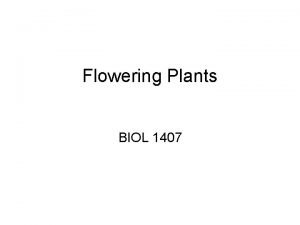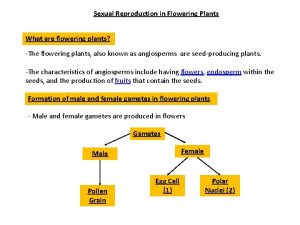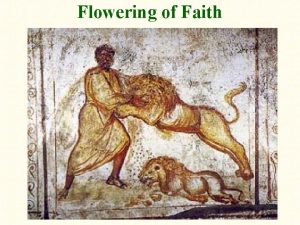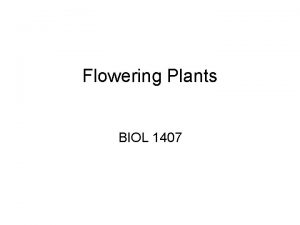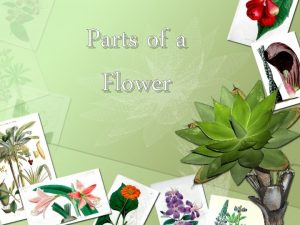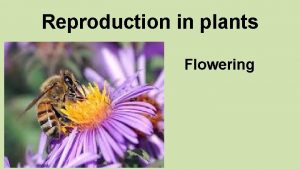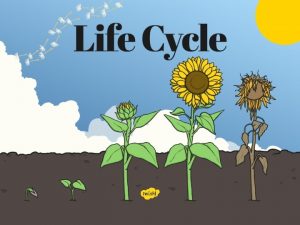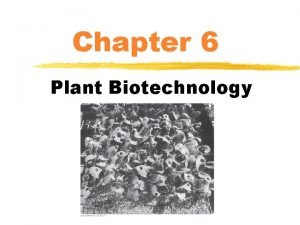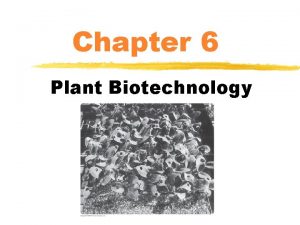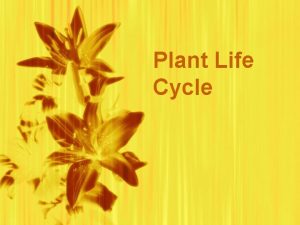CHAPTER 28 The Life of a Flowering Plant












































































- Slides: 76

CHAPTER 28 현화식물의 생활 The Life of a Flowering Plant







단자엽식물과 쌍자엽식물 Monocots and Dicots • 식물학자들은 여러 구조적 특징에 근거하여 피자 식물을 단자엽 식물과 쌍자엽 식물 2군으로 분류 한다. Seed leaves Leaf veins Stems Flowers Roots Monocots One cotyledon Veins usually parallel Vascular bundles in scattered arrangement Floral parts usually in multiples of three Vascular bundles arranged in ring Floral parts usually in multiples of four or five Fibrous root system Dicots Two cotyledons Veins usually branched Taproot usually present Figure 28. 2

• The names monocot and dicot refer to cotyledons, or seed leaves found in the embryo • Most angiosperms are dicots

Plant Organs: Roots, Stems, and Leaves • 식물체는 a root system and a shoot system으로 구성되며, 각각은 서로 의존한다.

Flower Terminal bud Node Internode Axillary bud Shoot system Leaf Petiole Blade Stem Taproot Root system Root hairs Figure 28. 3

Roots • A plant’s root system – Anchors it in the soil – Absorbs and transports minerals and water – Stores food • Root hairs – Are tiny projections near the root tips – Increase the surface area of the root



• Stems take many forms (a) Strawberry plant Runner (b) Potato plant Rhizome Tuber Taproot (c) Iris plant Root Rhizome Figure 28. 5


Figure 28. 6


Chloroplast Central vacuole Nucleus Endoplasmic reticulum Secondary cell wall Primary cell wall Mitochondrion Golgi apparatus Cell walls of adjoining cells Ribosomes Plasma membrane Microtubules Plasmodesmata Plasma membrane Figure 28. 7


Chloroplas (21) Nucleus 23) (22) ( (28) (29) (24) (25) Cell walls of adjoining cells Ribosomes (30) (26) (27) Plasma membrane Figure 28. 7

• 유조직 세포 (Parenchyma cells) – 대부분의 식물에서 가장 흔한 종류의 세포 – 음식 저장, 광합성 등 다양한 기능을 수행한다. (food storage and photosynthesis) Primary wall (thin) (a) Parenchyma cell Figure 28. 8 a

• 후각조직 세포 (Collenchyma cells) – 아직 성장하는 식물체 부위를 지지 Primary wall (thick) (b) Collenchyma cell Figure 28. 8 b

• 후벽조직 세포 (Sclerenchyma cells) – 두꺼운 2차 세포벽을 가지고 있어 식물체를 지 탱하는 기능 Secondary wall Primary wall (c) Sclerenchyma cell Figure 28. 8 c

• 물 통도 세포 (Water-conducting cells) – 뿌리에서 줄 기와 잎으로 물을 운반 Vessel element Tracheids Secondary wall Openings in end wall (d) Water-conducting cell Figure 28. 8 d

• 음식 통도 세포 (Food-conducting cells) – 식물체 여러 곳에 음식을 운반 Plasmodesmata Primary wall (e) Food-conducting cell Figure 28. 8 e

Plant Tissues and Tissue Systems • The cells of plants – Are grouped into tissues with characteristic functions • Plant tissues – Are organized into tissue systems

• Vascular tissue called xylem – Contains water-conducting cells • Vascular tissue called phloem – Contains food-conducting cells

• Roots, stems, and leaves are made up of three tissue systems – The dermal tissue system, the vascular tissue system, and the ground tissue system. Figure 28. 9 Leaf Stem Root Dermal tissue system (epidermis) Ground tissue system Vascular tissue system

• The epidermis – Covers and protects the leaves, young stems, and roots • The vascular tissue system – Is made up of xylem and phloem • The ground tissue system – Makes up the bulk of a young plant

• A cross section of a root shows what the three tissue systems look like under a microscope Figure 28. 10

• The three tissue systems in leaves Upper epidermis Mesophyll (ground tissue system) Lower epidermis Guard cells Xylem Vein Phloem Cuticle Vein Stoma Lower surface of leaf Stoma Guard cells Figure 28. 11

• Stomata, tiny pores that allow gas exchange – Occur in the epidermis of leaves • The mesophyll – Is the ground tissue system in a leaf

THE LIFE CYCLE OF A FLOWERING PLANT • Many plants can reproduce both sexually and asexually

• Through asexual reproduction, a plant can produce many identical plants quickly and efficiently Figure 28. 12

The Flower • Sexual reproduction in plants produces genetically distinct offspring

• In angiosperms – The structure specific to sexual reproduction is the flower Petal Stamen Carpel Anther Filament Stigma Style Ovary Ovule Sepal Figure 28. 13

• The flower’s reproductive organs are the stamen and the carpel

• The stamen, the male organ of a flower – Consists of the filament and the anther • In the anther – Meiosis occurs, producing pollen grains that house the cells that develop into sperm

• The carpel, the female organ of a flower – Consists of the stigma, style, and ovary • The stigma receives pollen grains • The style leads to the ovary, which houses ovules that contain developing eggs, at the base of the stigma

• The sexual life cycle of an angiosperm – Is defined as the time from when the plant begins to grow from a seed through flowering and seed production to death Embryo Ovary, containing ovule Fruit, Mature plant containing with flowers, seed where fertilization occurs Seed Germinating seed Seeding Figure 28. 14

Pollination and Fertilization • The plant life cycle – Alternates between haploid and diploid generations

• The diploid plant body – Is called the sporophyte • The haploid plant body – Is called the gametophyte

• Fertilization – Occurs when the female and male gametes unite, producing a diploid zygote • The life cycle is completed – When the zygote divides by mitosis and develops into a new sporophyte

• The formation of the male and female gametophytes Development of male gametophyte (pollen grain) Haploid nuclei of two cells Anther Mitosis Meiosis 1 Cell within 2 Four haploid anther spores 3 Pollen grain released from anther Two haploid nuclei of large, central cell Ovary Ovule Meiosis Development of female gametophyte (embryo sac) 1 2 Mitosis Surviving cell (haploid spore) 3 Embryo sac Egg cell (with haploid nucleus) Figure 28. 15

• The first step leading to fertilization is pollination, the delivery of pollen to the stigma of a carpel

Pollen grain 1 Pollination 2 Pollen grain Stigma germinates Pollen tube 3 Two sperm Triploid (3 n) nucleus Ovule Embryo sac 4 Double fertilization Diploid (2 n) zygote Egg cell Two sperm about to be discharged into ovule Figure 28. 16

• Many angiosperms are dependent on animals to transfer their pollen

• After pollination – The pollen grain germinates on the stigma forming two sperm • Each sperm fertilizes a cell in the ovule in a process called double fertilization – One fertilizes the egg, and the other fertilizes a second cell in the ovule

Seed Formation • After fertilization – The ovule begins developing into a seed

• The zygote – Divides via mitosis into a ball of cells that becomes the embryo • The endosperm also forms from the other fertilized cell and provides nourishment for the embryo

• The result of embryonic development is a mature seed with a tough protective seed coat Triploid nucleus of large, central cell Ovule Zygote Two cells Embryo Cotyledons Shoot Seed coat Root Endosperm Seed Figure 28. 17

Fruit Formation • A fruit – Is a matured ovary that houses and protects seeds and aids in their dispersal

• Pea pods – Are a type of fruit Figure 28. 18

• Fruits are highly varied Figure 28. 19

Seed Germination • Germination – Usually begins when the seed takes up water • The hydrated seed expands and bursts its seed coat

• Germination in a garden pea – Involves the formation of the root and then the shoot Embryonic shoot Foliage leaves Cotyledons Embryonic root Figure 28. 20

PLANT GROWTH • Most plants display indeterminate growth, continuing to grow as long as they live

• Species called annuals – Complete their life cycle in a single year or growing season • Species called biennials – Complete their life cycle in two years

• Plants known as perennials – Live and reproduce for many years Figure 28. 21

Primary Growth: Lengthening • Growth in all plants – Is made possible by tissues called meristems • A meristem – Consists of unspecialized cells that divide and generate new cells and tissues

• Apical meristems Terminal bud – Are found at the tips of roots and in the terminal and axillary buds of shoots Axillary buds Figure 28. 22 Root tips

• Primary growth – Consists of cell division in the apical meristems of roots and shoots – Produces the new cells that enable a plant to grow in length

Vascular system Elongation Root hair Cell division – Is pushed through the soil by primary growth – Contains a root cap that protects the actively dividing cells Differentiation • A growing root Cortex Epidermis Apical meristem region Root cap Figure 28. 23

Secondary Growth: Thickening • Secondary growth – Results in the thickening of stems and roots – Involves division in two meristems, the vascular cambium and the cork cambium

th • The vascular cambium – Gives rise to wood near its inner surface Grow Pith Primary xylem Vascular cambium Primary phloem Epidermis Cortex wth Gro Primary xylem Secondary xylem Vascular cambium Secondary phloem Primary phloem Sloughed off cells Cork cambium Second year First year wth Gro Secondary xylem (2 years’ growth) Vascular cambium Secondary phloem Bark Cork cambium Cork Figure 28. 24


th Grow (8) (9) (10) (11) (13) (12) wth Gro Primary xylem Secondary xylem Vascular cambium Secondary phloem Primary phloem Sloughed off cells (14) (15) wth Gro (16)year (17)year (18)Xylem (19) Secondary phloem (20) Cork cambium Cork Figure 28. 24

• The cork cambium – Is outside the vascular cambium and produces cork, one component of bark

• Over the years, a woody stem adds more layers, resulting in annual growth rings Rings Wood rays Heartwood Sapwood Vascular cambium Bark Secondary phloem Cork cambium Cork Figure 28. 25

EVOLUTION CONNECTION: THE INTERDEPENDENCE OF ANGIOSPERMS AND ANIMALS • Most angiosperms – Depend on various animals for pollination and seed dispersal

• The flowers of many angiosperms – Attract pollinators that rely entirely on the flowers’ nectar and pollen for food Figure 28. 26

• Many animals – Have very defined relationships with various flower species

SUMMARY OF KEY CONCEPTS • Monocots and Dicots Visual Summary 28. 1

• Plant Organs: Roots, Stems, and Leaves Flower (reproductive organ) Terminal bud Shoot system (photosynthetic center) Root system (anchors, absorbs, nutrients, and stores food) Stem (supports leaves and flowers) Axillary bud Internode Node Leaf (main Blade photosynthetic organ) Petiole Root hairs (microscopic; increase surface area for absorption) Visual Summary 28. 2

Pollen (n) • Pollination and Fertilization Ovary Ovule Embryo sac (n) Fertilization within ovule Fruit (from ovary) Mature plant (2 n) Seed (from ovule) Embryo (2 n) Germinating seed (2 n) Visual Summary 28. 3
 Classification of flowering and non flowering plants
Classification of flowering and non flowering plants Plants classification
Plants classification Characteristic
Characteristic Life cycle of a flowering plant
Life cycle of a flowering plant Moss is a flowering plant
Moss is a flowering plant What is the male part of a flower
What is the male part of a flower Slidetodoc.com
Slidetodoc.com Vegetables parts of plant
Vegetables parts of plant Plant introduction in plant breeding
Plant introduction in plant breeding Plant introduction in plant breeding
Plant introduction in plant breeding Plant introduction in plant breeding
Plant introduction in plant breeding Tronsmo plant pathology and plant diseases download
Tronsmo plant pathology and plant diseases download Tronsmo plant pathology and plant diseases download
Tronsmo plant pathology and plant diseases download Tronsmo plant pathology and plant diseases download
Tronsmo plant pathology and plant diseases download The flowering of romanticism summary
The flowering of romanticism summary The flowering of traditional china
The flowering of traditional china Main part of seed
Main part of seed Multiple choice questions on flowering plants
Multiple choice questions on flowering plants What is called
What is called Where does nitrogen come from
Where does nitrogen come from Ferns and algae kingdom
Ferns and algae kingdom Ethylene pineapple flowering
Ethylene pineapple flowering Female part of flower
Female part of flower Phylogenic
Phylogenic Unit 2 lesson 12 flowering plants
Unit 2 lesson 12 flowering plants Factors affecting flowering in plants ppt
Factors affecting flowering in plants ppt O serpent heart hid with a flowering face oxymoron
O serpent heart hid with a flowering face oxymoron Kiwibann
Kiwibann Plant organ
Plant organ Female parts of flowers
Female parts of flowers Eukarya plantae
Eukarya plantae The flowering of islamic civilization
The flowering of islamic civilization Flowering plum orchard van gogh
Flowering plum orchard van gogh Hình ảnh bộ gõ cơ thể búng tay
Hình ảnh bộ gõ cơ thể búng tay Frameset trong html5
Frameset trong html5 Bổ thể
Bổ thể Tỉ lệ cơ thể trẻ em
Tỉ lệ cơ thể trẻ em Chó sói
Chó sói Thang điểm glasgow
Thang điểm glasgow Alleluia hat len nguoi oi
Alleluia hat len nguoi oi Các môn thể thao bắt đầu bằng tiếng nhảy
Các môn thể thao bắt đầu bằng tiếng nhảy Thế nào là hệ số cao nhất
Thế nào là hệ số cao nhất Các châu lục và đại dương trên thế giới
Các châu lục và đại dương trên thế giới Công thức tính thế năng
Công thức tính thế năng Trời xanh đây là của chúng ta thể thơ
Trời xanh đây là của chúng ta thể thơ Cách giải mật thư tọa độ
Cách giải mật thư tọa độ Làm thế nào để 102-1=99
Làm thế nào để 102-1=99 độ dài liên kết
độ dài liên kết Các châu lục và đại dương trên thế giới
Các châu lục và đại dương trên thế giới Thơ thất ngôn tứ tuyệt đường luật
Thơ thất ngôn tứ tuyệt đường luật Quá trình desamine hóa có thể tạo ra
Quá trình desamine hóa có thể tạo ra Một số thể thơ truyền thống
Một số thể thơ truyền thống Cái miệng nó xinh thế chỉ nói điều hay thôi
Cái miệng nó xinh thế chỉ nói điều hay thôi Vẽ hình chiếu vuông góc của vật thể sau
Vẽ hình chiếu vuông góc của vật thể sau Biện pháp chống mỏi cơ
Biện pháp chống mỏi cơ đặc điểm cơ thể của người tối cổ
đặc điểm cơ thể của người tối cổ Giọng cùng tên là
Giọng cùng tên là Vẽ hình chiếu đứng bằng cạnh của vật thể
Vẽ hình chiếu đứng bằng cạnh của vật thể Phối cảnh
Phối cảnh Thẻ vin
Thẻ vin đại từ thay thế
đại từ thay thế điện thế nghỉ
điện thế nghỉ Tư thế ngồi viết
Tư thế ngồi viết Diễn thế sinh thái là
Diễn thế sinh thái là Các loại đột biến cấu trúc nhiễm sắc thể
Các loại đột biến cấu trúc nhiễm sắc thể Số.nguyên tố
Số.nguyên tố Tư thế ngồi viết
Tư thế ngồi viết Lời thề hippocrates
Lời thề hippocrates Thiếu nhi thế giới liên hoan
Thiếu nhi thế giới liên hoan ưu thế lai là gì
ưu thế lai là gì Hổ đẻ mỗi lứa mấy con
Hổ đẻ mỗi lứa mấy con Sự nuôi và dạy con của hươu
Sự nuôi và dạy con của hươu Sơ đồ cơ thể người
Sơ đồ cơ thể người Từ ngữ thể hiện lòng nhân hậu
Từ ngữ thể hiện lòng nhân hậu Thế nào là mạng điện lắp đặt kiểu nổi
Thế nào là mạng điện lắp đặt kiểu nổi Non domesticated animals and uncultivated plant life
Non domesticated animals and uncultivated plant life Perennial plant life cycle diagram
Perennial plant life cycle diagram

